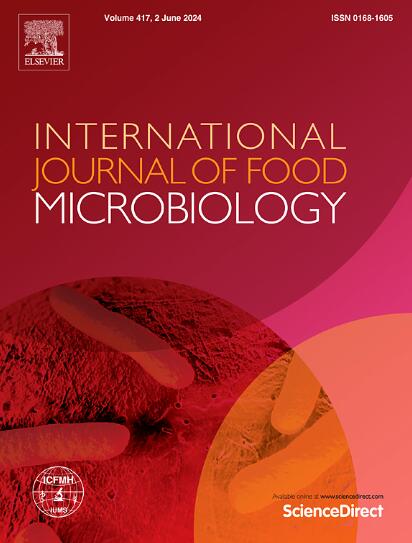乳清素与香茅醛对玉米镰刀菌的协同作用及其在玉米保鲜中的应用
IF 5
1区 农林科学
Q1 FOOD SCIENCE & TECHNOLOGY
International journal of food microbiology
Pub Date : 2025-06-26
DOI:10.1016/j.ijfoodmicro.2025.111331
引用次数: 0
摘要
稻谷镰刀菌(F. graminearum)是造成谷物赤霉病的罪魁祸首,它造成严重的产量损失,并产生真菌毒素污染食品和饲料。本文研究了乳清素和香茅醛联合施用对禾谷镰刀菌的拮抗作用。nisin与香茅醛联用不仅对禾谷镰牙菌孢子有增效作用(FICI <0.3125),而且对菌丝生长有显著抑制作用,对菌丝直径和菌丝重量的抑制率分别为(76.93±6.74)%和(95.24±4.33)%。nisin/citronella组合保持稳定的抗真菌活性,不受盐、高温和酸碱条件的影响。在机制上,香茅醛强烈抑制能量代谢,nisin显著降低麦角甾醇含量(据我们所知,nisin首次报道在F. graminearum中抑制麦角甾醇),香茅醛和nisin联合使用进一步增强了对真菌细胞膜的破坏。此外,由于剂量减少和多种机制的参与,30代后,nisin/citronellal联合用药未诱导禾谷镰刀菌产生耐药性,MIC倍数变化为0.25 ~ 2倍。结果表明,该组合能有效抑制玉米真菌污染。综上所提,乳清素和香茅醛可在食品和饲料工业中共同用于防治禾谷镰牙菌。尽管nisin和香茅醛的生产成本仍然高于合成杀菌剂,但生物技术的不断发展正在推动它们在收获后粮食储存中的应用。本文章由计算机程序翻译,如有差异,请以英文原文为准。
Synergism between nisin and citronellal against Fusarium graminearum and their application in maize preservation
Fusarium graminearum (F. graminearum), responsible for Fusarium head blight in cereals, causes significant yield losses and produces mycotoxins contaminating food and feed. The combined effects of nisin and citronellal against F. graminearum were investigated in this study. The combination of nisin and citronellal not only exhibited a synergistic effect against F. graminearum spores (FICI <0.3125), but also significantly inhibited mycelial growth, with inhibition rates of (76.93 ± 6.74) % and (95.24 ± 4.33) % for mycelial diameter and weight, respectively. The nisin/citronellal combination maintained stable antifungal activity independent of salts, high temperature, and acid–base conditions. Mechanistically, citronellal strongly inhibited energy metabolism, nisin significantly reduced the ergosterol content (to our knowledge, the first report of nisin suppressing ergosterol in F. graminearum), and the combination of citronellal and nisin further enhanced disruption of fungal cell membranes. Moreover, due to the reduced dosage and involvement of multiple mechanisms, the nisin/citronellal combination did not induce resistance in F. graminearum after 30 generations, with MIC fold changes of 0.25 to 2. Finally, the combination effectively suppressed fungal contamination in maize. Overall, nisin and citronellal could be used together for controlling F. graminearum in food and feed industries. Although the production costs of nisin and citronellal remain higher than those of synthetic fungicides, the continuous development of biotechnology is driving their application in post-harvest grain storage.
求助全文
通过发布文献求助,成功后即可免费获取论文全文。
去求助
来源期刊
CiteScore
10.40
自引率
5.60%
发文量
322
审稿时长
65 days
期刊介绍:
The International Journal of Food Microbiology publishes papers dealing with all aspects of food microbiology. Articles must present information that is novel, has high impact and interest, and is of high scientific quality. They should provide scientific or technological advancement in the specific field of interest of the journal and enhance its strong international reputation. Preliminary or confirmatory results as well as contributions not strictly related to food microbiology will not be considered for publication.

 求助内容:
求助内容: 应助结果提醒方式:
应助结果提醒方式:


